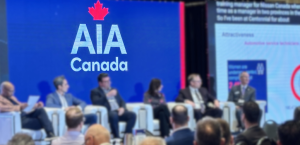Toronto, Ontario — Policy can change everything—just look to New Zealand’s aftermarket for proof of how electric vehicles can completely alter the aftermarket.
A featured speaker at Collision Repair magazine’s EV Repair Tour, supported by Fix Network, Martyn Johns, NAPA/UAP’s national director of emerging technologies, delivered a wake-up call presentation, where he called on collision repair centres to start preparing for vehicle electrification immediately.
During his discussion, Johns noted the New Zealand government’s “overnight” decision to introduce a $8,000 subsidy for hybrid or electric vehicles less than four years old. Used electric vehicles were accepted under the change, prompting a massive wave of imports from the Chinese EV market.
“In the last 18 months, 40 percent of the vehicles sold in New Zealand’s market were used hybrid or electric vehicles, about three years old, imported from China.
“Their aftermarket got demolished in about 12 months. Not one technician—nobody—was ready.
“This is where we say, ‘Oh, we’ve got years!’ Even today, I’ve had those conversations. Policy can change everything.”
“As an organization, we [at NAPA] look at this as a threat to the industry’s long-term success. You [as businessowners] need to know when you’re going to make an investment and how you actually execute this investment—because there must be a return on it.”
He said that, for many aftermarket repair facilities, the ROI on EV endeavours does not equal immediate cash flow—it’s a five-year plan to be industry-leading and capture the first waves of EV business.
“The people that are getting in now—there is no ROI. It’s all about being the first movers right now.”
While the aftermarket has traditionally been late to adopt widespread change, Johns said the shift to electric vehicles is “the material change.”
“There is one chance to get market share out of this fundamental change to the industry, and it’s going to happen in the next 18 months.
“People are making the investments [in EV repair capability] and see the opportunities—they’re not listening to those other people saying, ‘It’s not going to happen,’ or ‘It’ll happen in five years. We’re not ready!’
“It is happening. And it is happening at a level beyond what we see right now.”
Johns stressed that it is absolutely critical that the collision industry prepares for electric vehicles as “huge organizations” scratch their heads over solutions.
“Huge organizations globally do not have the capacity to do what everyone in this room can do,” Johns told the crowd of collision repair industry stakeholders.
“It’s a massive opportunity. And, as a supplier, we want to empower [the aftermarket repair facilities] to make a boatload of money. Average labour rates are 40 percent higher than on internal combustion engines; training and long-term certification of a technician is between $15k and $20k.”
Johns also gave a shout-out to the Quebec government for its “unbelievable forethought” in the shift to electrification.
“The Quebec government has invested tens of millions of dollars in multiple different projects for the sole purpose of getting a return on investment for the hundreds of millions of dollars they’ve made in battery recycling, OE production, manufacturing facilities—those are billion-dollar bets.
“None of those bets are successful unless the [industry] can fix them, maintain them and do the bodywork on those vehicles once they are deployed.”
Subscribe and stay tuned for video content and more coverage from Collision Repair magazine’s EV Tour Toronto.





































